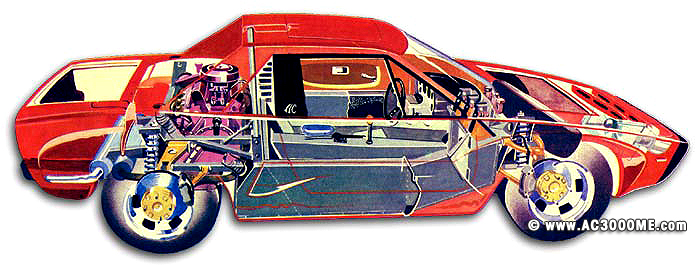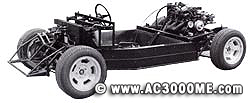Buyers Guide
106 AC 3000ME's were built in total, 76 by AC Cars in Thames Ditton and 30 by AC Scotland. Chassis numbers start at 104, yet 105 and 107 were never used. The last Thames Ditton car was 182 and the last car of all was 212. Some have been used to make special concept cars.
Most of the Thames Ditton cars have black bonnet air intakes, while most of the Scottish cars have the air intakes painted the same colour as the car. (But not all) Some people think that the Thames Ditton cars are best but they are all very similar, in fact it is more likley that each car made was slightly different than the others which is always the way with hand built cars.
Out of the Thames Ditton cars 17 were fitted with a turbo by Robin Rew at Silverstone. You can always tell a turbo as it only has one tail pipe, however many of the Turbo's have been removed.
The bodywork is fibreglass that is not prone to problems but surface cracks and small paint bubbles can sometimes be seen. The paint bubbles is not serious but normally a problem with the undercoat of the cellulose paint. The cars were undercoated, left to dry and then top coated the following day, the bubbles are caused by the top coat being applied with dampness in the air from the overnight wait..

The Interior comes was cloth as standard but leather seats were an optional extra. Check the outer edge of the seat cushions as they can wear due to friction when the driver gets in and out of the cockpit. The carpets wear and rot but a replacement set is available and not a major problem to fit. Always check under the carpets as the seal between the body and chassis often slightly leaks and water sits in the foot well soaking the foam underlay. This can cause serious rust. especially behind and under the seats.
Some cars have been fully rebuilt mainly due to chassis rust problems. Some of these cars have been fitted with a stainless steel chassis, (6 were made) and some have galvanised subframes fitted.
 The standard chassis is made of steel and is in 3 main parts. A front sub-frame, a centre tub and a rear sub-frame. If the car has been used in the wet, check for corrosion which can be bad. The places to look are under the carpets behind the seats, sub-frame mounting points and just below the sills. The main parts were made from flat sheet and tubing but they were simply bolted together and these areas can suffer. Check the front subframe where the anchor points are for the lower wishbones. Just under the sill on each side is a trim which has a rubber seal above it. It was designed to keep water and salt out but had the opposite effect in not letting it dry away. All the chassis was sprayed with was a black etching paint that AC thought would last for ever but the fact is it drops off in large flakes. Modern rust treatment were not available in the 70's so expect some rust. If you cannot remove the sill seal to check for rust, (Many are removed for drainage) push a flat rule in parallel to the ground between the top of the seal and the sill, if the rule only goes in a short distance and you hit something solid, its the outer part of the chassis, if it goes in 2 inches then you may well have gone through the rusted outer chassis to the inner chassis so there is severe rust problems.
The standard chassis is made of steel and is in 3 main parts. A front sub-frame, a centre tub and a rear sub-frame. If the car has been used in the wet, check for corrosion which can be bad. The places to look are under the carpets behind the seats, sub-frame mounting points and just below the sills. The main parts were made from flat sheet and tubing but they were simply bolted together and these areas can suffer. Check the front subframe where the anchor points are for the lower wishbones. Just under the sill on each side is a trim which has a rubber seal above it. It was designed to keep water and salt out but had the opposite effect in not letting it dry away. All the chassis was sprayed with was a black etching paint that AC thought would last for ever but the fact is it drops off in large flakes. Modern rust treatment were not available in the 70's so expect some rust. If you cannot remove the sill seal to check for rust, (Many are removed for drainage) push a flat rule in parallel to the ground between the top of the seal and the sill, if the rule only goes in a short distance and you hit something solid, its the outer part of the chassis, if it goes in 2 inches then you may well have gone through the rusted outer chassis to the inner chassis so there is severe rust problems.
The fuel tank and its mounting can also suffer from rust but many tanks have been replaced with stainless steel or galvanized ones.
The engine is a standard Ford Essex V6 3.0ltr as fitted to Capri of the time but as the engine was no longer fitted in the Capri after 1981 the engine was imported from Ford South Africa. The engine is turned through 90degrees so it fits transversely across the car just behind the driver in a mid-engine configuration. ME refers to Mid-Engine. The standard engine runs on LEADED fuel.
The gearbox has an AC alloy case fitted with Hewland gears and it sits under and behind the engine replacing the V6 sump. The engine has its own sump in this case and the gearbox has its own oil sump and dipstick which is also the gearbox filler. The drive from the engine is via a special Triplex (3 row) renold chain. The gear change seems to be a week spot with a Ferrari type chrome gate. If the bushes in the gear linkage are worn you may have to lift the lever to change gear. This is an easy fix. On higher mileage cars expect to renew some bearings, gears and even the crown wheel and pinion.
The wheels should be Wolfrace slotted alloys and replacements are very difficult to find so check for damage. The chrome wheel nuts always seem to be rusty.
Most parts are available one way or another but unlike a kit car that uses parts from production cars the AC 3000ME uses several special factory made parts that can be rather expensive.
The AC 3000ME will always be a rare car, most people have never even seen one. Its looks are ageless and its terrific to drive. Where ever you stop you will be approached by casual onlookers unable to restrain their curiosity, and even worse some will think its a kit car. The car is useable and as most were only ever bought as second cars, they have been kept in great condition. For a sports car there is not much that can beat it for boot space, but remember its a 1970's design and compared to other 70's cars it was way ahead of its time. It even has electric windows that are standard on almost everything these days but was a great luxury in the 70's. Several owners have 2 or even 3 and many owners have had several different ones in their time.
What should you pay?
Expect to pay £12,000 to £13,000 for reasonable car, a real mint one as high as £17,000 to £22,000. One in very poor condition that need a rebuild about £7,000 (updated June 2013). But lets make one thing very clear, they are not that easy to find and are snapped up rather quickly. They will normally be worth the same or a bit more than you paid and if you spend a bit of time keeping your car right you may well be suprised.